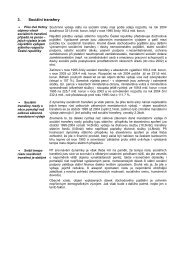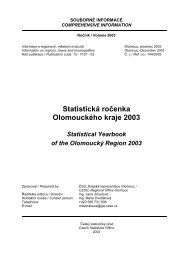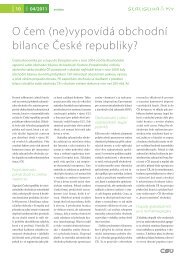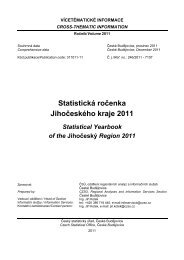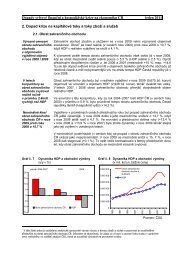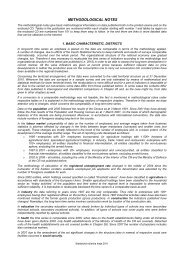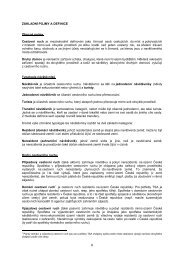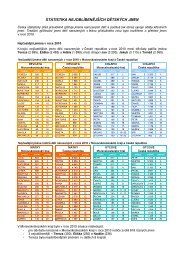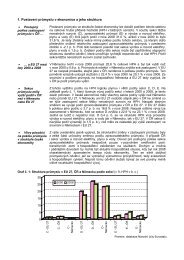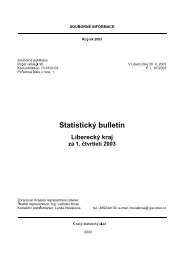Statistická ročenka Olomouckého kraje 2011 - Český statistický úřad
Statistická ročenka Olomouckého kraje 2011 - Český statistický úřad
Statistická ročenka Olomouckého kraje 2011 - Český statistický úřad
You also want an ePaper? Increase the reach of your titles
YUMPU automatically turns print PDFs into web optimized ePapers that Google loves.
A town means a municipality, which has been granted the status of town pursuant to the Act on Municipalities. Tables<br />
25-10 and 25-11 give an overview of towns in the respective regions in an alphabetical order. Table 25-12 contains<br />
selected data on regional towns of the Czech Republic in the order by the size of population.<br />
A municipality is a basic territorial self-governing community of citizens. It forms a territorial unit defined by boundaries.<br />
Table 25-13 gives selected data on respective municipalities pooled together to make administrative districts of<br />
municipalities with extended powers (according to the territorial structure valid as at 31 December 2010). The figure in<br />
brackets following the name of an administrative district is an official numerical code corresponding to the nomenclature<br />
issued by the CZSO.<br />
The population at population census means the number of persons registered for the permanent residence in some of<br />
the municipalities of the administrative district. Since 2001 this number also includes foreigners with a long-term<br />
residence on the relevant territory. Data were grossed up to the territorial structure valid as at 31 December 2010.<br />
The unemployment rate was calculated as a share of the number of available job applicants as at 31 December of the<br />
relevant year and the number of economically active persons according to the Population and Housing Census as at<br />
1 March 2001.<br />
The facilities of municipalities were determined by means of territorial method (including detached workplaces)<br />
regardless of the head office or seat of the operator. The municipality is considered to be equipped with the given facility,<br />
if one part of the municipality, as minimum, is equipped with it. The number of economic entities includes also entities,<br />
which have their head office or seat (not only a branch) on the given territory and are economically active (the CZSO has<br />
no report on their inactivity).<br />
26. TERRITORIAL COMPARISONS<br />
Based on the Constitutional Act No. 347/1997 Sb., on the Establishment of Higher Territorial Self-Governing Units of<br />
3 December 1997, the Czech Republic was subdivided into 14 regions on 1 January 2000. The Czech Statistical Office<br />
introduced the Classification of Territorial Statistical Units (CZ-NUTS) according to this Act and the Decision of the<br />
Government of the Czech Republic No. 707/1998, and Section 19, paragraph 1 of the Act No. 89/1995 Sb. on the State<br />
Statistical Service, and following an agreement with the Statistical Office of the European Communities (Eurostat).<br />
The NUTS (La Nomenclature des Unités Territoriales Statistiques) classification constitutes a fundamental systematic<br />
tool for the needs of statistics, analyses, and needs of providing of statistical information to the European Union. It is<br />
used for the statistical monitoring and analyses of social and economic conditions in the regions, as well as for the<br />
preparation, implementation, and evaluation of regional policies. At the level of NUTS 2 it is, in particular, used for the<br />
drawing finances from the so-called Structural Funds of the EU.<br />
Effective since 1 January 2008 the Classification of Territorial Statistical Units (CZ-NUTS) was updated by the<br />
Communication of the CZSO No. 201/2007 Sb. At present the Classification has four levels of NUTS, which are<br />
characterized by population and area. At lower levels so-called “Local Administrative Units” (LAU) have been introduced.<br />
The EU legislation instruments, however, do not introduce the LAU system.<br />
NUTS 0 refers to the state of the Czech Republic<br />
NUTS 1 refers to the territory of the Czech Republic<br />
NUTS 2 refers to areas (cohesion regions), i.e. to 8 groupings of regions<br />
NUTS 3 refers to 14 regions, i.e. to higher territorial self-governing units - HTSU<br />
LAU 1 refers to districts, i.e. to 76 districts and Hl. m. Praha in total<br />
LAU 2 refers to municipalities, i.e. to 6 250 municipalities (Hl. m. Praha is one unit)<br />
Overview of NUTS 2 areas and NUTS 3 regions:<br />
Praha<br />
- Hl. m. Praha Region (Capital City of Prague)<br />
Střední Čechy - Středočeský Region<br />
Jihozápad - Jihočeský and Plzeňský Regions<br />
Severozápad - Karlovarský and Ústecký Regions<br />
Severovýchod - Liberecký, Královéhradecký, and Pardubický Regions<br />
Jihovýchod - Kraj Vysočina and Jihomoravský Regions<br />
Střední Morava - Olomoucký and Zlínský Regions<br />
Moravskoslezsko - Moravskoslezský Region<br />
204<br />
<strong>Statistická</strong> <strong>ročenka</strong> <strong>Olomouckého</strong> <strong>kraje</strong> <strong>2011</strong>



